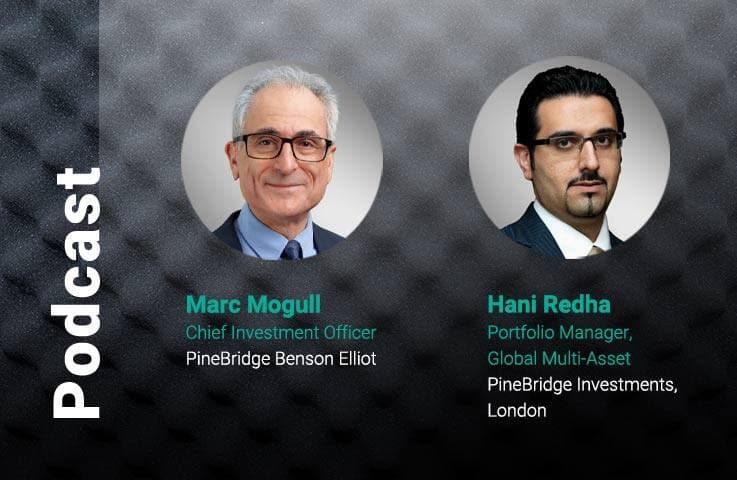Investment Strategy Insights: Commercial Real Estate: A Systemic or Cyclical Risk?

Hani Redha, CAIA
Portfolio Manager, Head of Strategy and Research for Global Multi-Asset

Along midtown Manhattan’s prime office thoroughfares, the familiar hustle of office workers grabbing lunch or heading to and from subway and commuter trains has been replaced by a subdued ambience. In New York and other major US cities, the shift to remote work due to Covid has resulted in the seeming permanence of hybrid working arrangements, leading to sparsely populated office buildings and a sharp reduction in demand among corporate tenants.
Adding to concerns about reduced office demand is the current weakness in regional banks, culminating in tighter credit conditions for commercial real estate (CRE) loans. This, combined with continued interest rate hikes, has weakened CRE fundamentals and increased the cost of capital, leading to diminished asset values. With US office buildings accounting for roughly 39% of banks’ CRE loan portfolios (or about $1 trillion1), and a wall of maturing loans across the ecosystem ($448 billion in 2023 and 60% held by banks1;), the growing weakness in the office market has triggered fears of widespread CRE defaults that would lead to further credit tightening and a deeper economic slowdown.
In contrast, major European cities’ CRE markets are better positioned, in part due to a greater percentage of workers returning to the office. European real estate is generally financed with lower leverage, as bank lending rules put a damper on developer leverage. Furthermore, European banks are in a more robust position compared to US regional banks, thereby experiencing less pressure to reduce or amend loans to developers. With lower vacancy rates to begin with, last year’s fourth quarter saw demand for European prime office space rise by 6.2% year-on-year, the strongest annualized reading since mid-2008.2
Nevertheless, it is important to note that the CRE sector overall exhibits enormous dispersion. Commercial real estate encompasses not just office buildings but diverse assets including the thriving multi-family housing and medical facilities subsectors. The more developed US commercial mortgage-backed securities (CMBS) market provides greater financing flexibility, and office defaults remain low in this $4.4 trillion market.
As such, opportunities persist for active management, given the substantial performance dispersion anticipated across the sector. In the US market, we believe high-quality assets (such as AAA rated bonds) offer attractive opportunities, while the European market presents more opportunistic situations requiring careful asset selection.
The CRE sector, particularly in the US, is undoubtedly under pressure. However, we do not foresee a global financial crisis, nor a balance sheet recession, stemming from this sector, as CRE loss levels within bank portfolios are likely to remain significantly lower than for subprime loans during the financial crisis. Moreover, the vulnerability is contained in a relatively small part of the overall economy, compared to residential real estate.
Although recessions can certainly cause unexpected feedback loops, CRE is not likely to be a systemic risk. It is, however, a cyclical risk that will persist for years to come, and it will continue to contribute to credit tightening and slowing of the economy, particularly in the near term.
At the macro level, the CRE sector is merely the latest financial asset class hit by the central bank U-turn away from free money. SPACs, crypto, unprofitable spec-tech, and now CRE have one key factor in common – they experienced the pain of liquidity withdrawal on a scale never before seen, leading to destruction of capital. The previous economic regime is well and truly behind us. Ongoing liquidity withdrawal will continue to pressure most financial assets, making active management imperative.
Conviction Score (CS) and Investment Views
The Conviction Scores shown below reflect the investment team’s views on how portfolios should be positioned for the next six to nine months. 1=bullish, 5=bearish, and the change from the prior month is indicated in parentheses.
Global Macro
CS 3.50 (unchanged)
Stance: Further signs of a US economic slowdown have emerged, and with sales and price growth edging lower simultaneously, it follows that softening demand is the main driver. This was clear in the March ISM survey data: Inventories, backlogs, and new order components are now all contracting for the first time since the last recession. Despite OPEC’s surprise supply cut, which trimmed 1.5% of total global supply, oil prices have risen only to year-to-date (YTD) averages, indicating sluggish demand. This is corroborated by credit growth, which has quickly turned negative as lending standards swiftly tightened, driving financial conditions tighter. The index of small business optimism is now at its lowest level in 10 years. The question now is not if the US will enter a recession but when, and how severe it will be. The labor market and wage indices, both lagging indicators, show that a sharp downturn likely isn’t in the cards. Subsequent rate cuts likely will echo this. Since producer price index (PPI) services lead consumer price index (CPI) services by roughly six to nine months, and with the former at a 24-month low at 2.7% year-over-year (y/y) in March, momentum is building on the disinflation front, despite a still-sticky core CPI print in March. China’s rebound has been strong, with exports in March rising by 14.8% y/y (up from -1.3%) and money supply growth at the highest level since 2016. The impact on the rest of the world, however, has been more services-related than goods-related, as evidenced by the climb in the Global Services PMI. But with commodity prices still holding up well, the overall picture bodes well for emerging markets (EMs), where a strong boost in terms-of-trade and an external account reset are underway. EM strength stands in contrast to developed markets (DMs), where the euro-area economy has softened, with contractions in new loans and retail sales.
Outlook: Almost all central banks have reached the end of their hiking cycles, as pricing pressures are softening and economic momentum is slowing. Growth, however, will accelerate in a number of EM countries, mainly as a function of their involvement with China.
Risks: 1) The steady slowdown in US economic momentum turns into a quick deceleration due to the severity of tightening, debt-ceiling jitters, or the coming student loan cliff; 2) Systemic issues arise in either Europe or the US; and 3) Fiscal policy stimulus returns and supports more resilient economic fundamentals across Europe and the US.
Rates
Gunter Seeger, CFA Portfolio Manager, Developed Markets Investment Grade
CS 3.50 (unchanged)
After the Federal Reserve raised rates by 25 basis points (bps) at the end of March, the curve flattened. With the interest rate on excess reserves (IOER) now at 4.90%, the highest point on the US Treasury curve, we think hoarding cash at the Fed is the best move any bank can make, especially those concerned about runs. We believe a period of maximum volatility is coming that won’t let up anytime soon. Anticipate liquidity pullbacks in every area of banking, including US Treasuries, mortgage-backed securities, and commercial real estate. Another sign of risk: Bid-ask spreads in the T-bill market, now at about 40 bps, are twice the average.
Credit
Steven Oh, CFA Global Head of Credit and Fixed Income
CS 3.25 (unchanged)
The elevated volatility that accompanied fears of a banking crisis has abated, but additional challenges face many regional banks, and tightening lending conditions will filter into the broader economic and earnings slowdown. The negative earnings trend and the lagged effect from rate increases should reveal themselves in the second half. Despite those headwinds, appetite for risk assets should not materially diminish absent a more sustained shock. Therefore, we maintain a marginally defensive bias rather than a shift to hyper defensiveness. While negative trends pervade developed markets (DMs), many EM nations, particularly in Asia, should see improving fundamentals. While EM valuations are not cheap and in part reflect the sector’s positive outlook, the credit trend warrants a tilt toward areas of improving fundamentals. With the US and the dollar now potentially weakening relative to other markets and currencies — contrary to our view of US strength a year ago — portfolios should extend more globally beyond the US.
Currency (USD Perspective)
Anders Faergemann Senior Sovereign Portfolio Manager, Emerging Markets Fixed Income
CS 3.75 (+0.75)
The fallout from the US regional bank crisis and threat of a credit crunch increase the risk of a US-only recession, which would tend to lead to underperformance of the US dollar against a broad range of currencies. Effectively, higher fed fund rates wind up being too low to eliminate core inflation, while at the same time far too restrictive for financial stability and economic growth. This suggests that the initial unwinding of restrictive monetary policy will commence in the first quarter of 2024. Adding to the woes of the US dollar, US/European yield differentials are shrinking, and we expect a further narrowing of the US Treasury/bunds rate differential over the next 12 months. Altogether, we end up with a much weaker outlook for the US dollar in the second quarter than previously anticipated, while our 12-month outlook remains mildly bearish subject to the magnitude of the US recession and the level of global contagion. We have revised our 12-month euro/US dollar forecast higher into the 115 area as our 2021-2022 theme of US exceptionalism sunsets. The US dollar tends to have a negative relationship to global growth and has underperformed EM currencies during periods of a US-only recession. China’s reopening from Covid helps bolster EM activity and supports a widening of the EM/DM growth differential.
Emerging Markets Fixed Income
Chris Perryman Managing Director, Corporate Portfolio Manager and Head of Trading, Emerging Markets Fixed Income
USD EM (Sovereign and Corp.)
CS 2.75 (-0.25)
Local Markets (Sovereign)
CS 2.75 (-0.25)
The probability of weather patterns shifting late this year due to the El Nino effect, which raises water temperatures in the Pacific near Central and South America, bears watching. It could benefit coffee growers in Argentina and Brazil while hurting wheat crops in Peru, India, and Australia. Global food prices already are showing significant declines irrespective of El Nino amid beneficiary base effects in oil prices, fertilizer prices, and shipping. With US regional bank failures and the possibility of a credit crunch increasing risks of a US recession in the second half, we have reduced the likelihood of a US “soft landing” from 20% to 10%. Economic uncertainty increasingly seems limited to the US, which could indicate that a US-only recession is in the cards, which would typically cause a weakening of the US dollar.
Continued resilience in EM fundamentals, improving technicals, and positive real rates make EM local markets increasingly attractive. Overall, the narrative has turned more positive on US Treasuries and investment-grade (IG) fixed income. The severity of the credit crunch and the US recession will dictate the outcome for credit risk and high yield (HY) markets, but generally we are optimistic on EM HY too. Stable to improving credit trends in EM corporates argue in favor of allocating to corporate debt, while demand for extending duration and improving risk appetite may shield EM sovereign debt from further spread widening.
Multi-Asset
Mary Nicola Senior Vice President, Portfolio Manager, Global Multi-Asset
CS 3.50 (unchanged)
While we are maintaining our cautious Risk Dial Score at 3.5, we believe the resilience of US households and businesses, as well as the capital and liquidity in the US banking system, will prevent the impending cyclical income statement recession from devolving into a balance sheet recession akin to the global financial crisis. Nonetheless, we anticipate accelerated credit and regulatory tightening, as well as net margin squeezes at small businesses, which have been the drivers of jobs and excess demand. The reduced credit availability likely will pull forward cyclical pressures that previously were being pushed out owing to improvements in Europe and China. The European banking system, healthier than its US counterpart, also is enjoying positive momentum from the inflation relief accompanying a surprisingly warm winter. China’s recovery is gathering strength from surprising pivots toward reopening and pragmatism. Suddenly, the US looks like the weakest link, which is likely to put ongoing downward pressure on the elevated US dollar.
Global Equity
Ken Ruskin, CFA Director of Research and Head of Sustainability, Global Equities
CS 3.00 (+0.25)
As we head into earnings season, our conversations with companies still indicate stability: In short, bottom-up optimism is outweighing top-down worries for the moment. Management teams have guided conservatively for the second half of the year as there is very little visibility beyond the upcoming quarter. The recent banking concerns create incremental risks related to credit quality/availability in future months.
Cyclical stocks have underperformed in the past month, with financials being the first to be affected, but industrials have felt the secondary impact of incremental recession fears recently. Supply chain pressures are easing, but that will likely lead to order declines, which could create more investor caution in the short term. We continue to find opportunities to invest in companies that are benefiting from our long-range growth themes, though we are incrementally more cautious, as we may see more attractive entry points as cycle fears play out. As always, portfolio style balance remains a key component of our risk management.
Global Emerging Markets Equity
Taras Shumelda Senior Vice President, Portfolio Manager, Global Equities
CS 2.50 (unchanged)
Our score remains unchanged amid little tangible movement in EM despite considerable geopolitical noise and DM banking woes. Based on our analysis, there is little risk of Silicon Valley Bank-style contagion in global EMs, but we are watching developments intently. In China, home appliance and furniture companies are being driven by the recovering housing market. Travel-related demand expectations and investment flows to artificial intelligence and electric vehicles remain strong. Smartphone sales have been muted recently. In India, banks continue to witness strong credit growth, while heavy industries including electricity, coal, cement, steel, and energy also continue to show good growth. With global energy prices coming down, margins of Indian companies should rise, and inflation should remain under control. In Latin America, there is increasing divergence of performance between Mexico and other markets. The former has emerged as an area of relative political and economic stability in a region that faces multiple challenges. In Central and Eastern Europe, companies have adapted to the Ukraine war’s impact and benefit from the low base set in 2022.
Quantitative Research
Qian Yang Vice President, Fixed Income Quantitative Strategist
We increased our US Conviction Score slightly, largely due to contributions from the steeper curve (higher by 31 bps), which more than offset the negative contribution from widening credit spreads, which were up 20 bps for BBBs. Our global credit forecasts remain positive on EM over DM. In DM, our model favors capital goods, industrials, technology, and consumer cyclicals, and dislikes financials, REITs, energy, and banking. In EM countries, our model likes Argentina and Taiwan. Among EM industries, it likes metals, real estate, and technology, media, and telecom. The model dislikes utilities, transportation, and pulp and paper. Our global rates model forecasts lower yields globally; a flatter curve in Europe, the UK, and Oceania; a slightly flatter curve in Japan; and a steeper curve in the US and Canada. The rates view expressed in our G10 model portfolio is overweight global duration and overweight North America and Japan.
Disclosure
Investing involves risk, including possible loss of principal. The information presented herein is for illustrative purposes only and should not be considered reflective of any particular security, strategy, or investment product. It represents a general assessment of the markets at a specific time and is not a guarantee of future performance results or market movement. This material does not constitute investment, financial, legal, tax, or other advice; investment research or a product of any research department; an offer to sell, or the solicitation of an offer to purchase any security or interest in a fund; or a recommendation for any investment product or strategy. PineBridge Investments is not soliciting or recommending any action based on information in this document. Any opinions, projections, or forward-looking statements expressed herein are solely those of the author, may differ from the views or opinions expressed by other areas of PineBridge Investments, and are only for general informational purposes as of the date indicated. Views may be based on third-party data that has not been independently verified. PineBridge Investments does not approve of or endorse any republication of this material. You are solely responsible for deciding whether any investment product or strategy is appropriate for you based upon your investment goals, financial situation and tolerance for risk.




